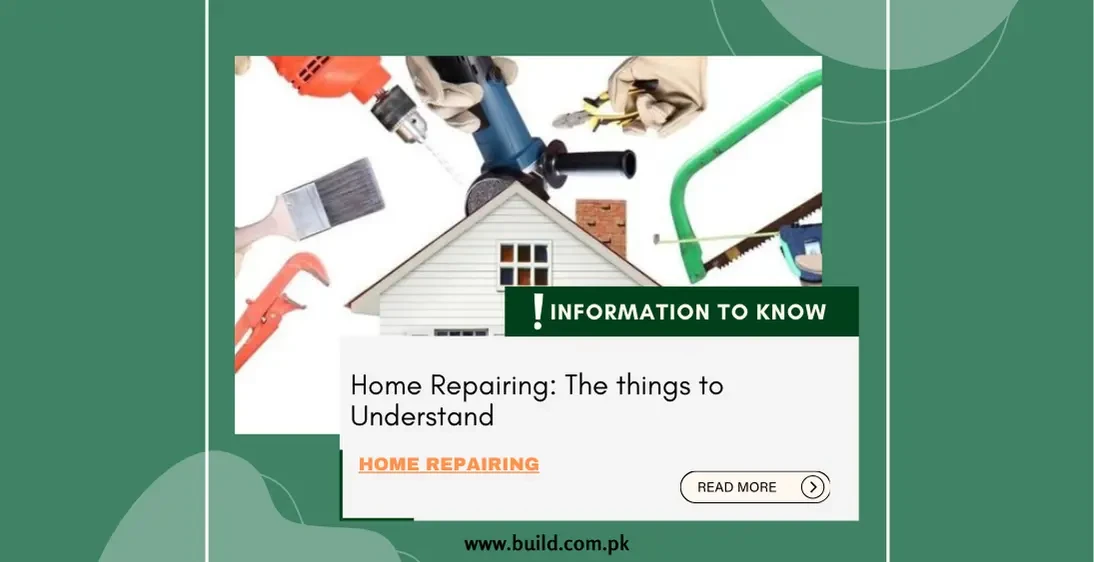Home Repairing: The things to Understand

Introduction:
Maintaining
a home involves a variety of tasks aimed at preserving its structural
integrity, functionality, and aesthetic appeal. From routine maintenance to
addressing unexpected issues, effective home repairing ensures a safe and
comfortable living environment. This guide delves into the nuances of different
repair types, considerations for DIY projects versus professional help, common
repair projects, and budgeting tips.
Understanding Home Repair
Importance of Regular Maintenance:
Regular
maintenance plays a critical role in preventing minor issues from escalating
into major problems. It includes tasks like inspecting plumbing for leaks,
testing electrical systems for faults, and inspecting roofs for signs of
damage.
Types of Home Repairs
Plumbing Repairs:
These encompass fixing leaks, clearing clogged drains, replacing
faucets, and maintaining water heaters. Plumbing issues can range from minor
inconveniences to severe water damage if not promptly addressed.
Electrical Repairs:
Electrical repairs involve troubleshooting issues such as faulty
wiring, malfunctioning outlets, and electrical panel problems. Safety is
paramount, and repairs should adhere to local codes and regulations.
Structural Repairs:
Structural repairs focus on maintaining the stability and safety of
the home. This includes addressing foundation cracks, repairing damaged walls
or floors, and reinforcing weakened structures.
Interior and Exterior Repairs:
Interior repairs may involve patching drywall, repairing
flooring, or fixing doors and windows. Exterior repairs often include
maintaining siding, repairing fences, and addressing drainage issues to protect
against water damage.
DIY vs. Professional Help
DIY Home Repairs:
Tools
and Equipment: Basic tools like screwdrivers, wrenches, hammers, and a tape
measure are essential for DIY repairs. Specialized tools may be necessary for
specific tasks.
Skill
Level: DIY repairs are suitable for individuals with basic skills in carpentry,
plumbing, or electrical work. Online tutorials and DIY guides can provide
step-by-step instructions for many common repairs.
Safety
Considerations: Always prioritize safety by wearing protective gear and
understanding the risks associated with electrical and structural repairs.
When to Hire a Professional:
Complexity
of Repairs: Major structural repairs, electrical rewiring, and significant
plumbing overhauls should be handled by licensed professionals with expertise
in their respective fields.
Time
Constraints: Professionals can expedite repairs, especially for time-sensitive
issues or extensive renovations requiring specialized knowledge and equipment.
Legal
and Safety Compliance: Certain repairs, such as electrical or structural
modifications, may require permits and adherence to building codes.
Professionals are well-versed in these regulations.
Common Home Repair Projects
Roof Repairs:
Identification
of Issues: Regularly inspect the roof for missing or damaged shingles, signs of
water leakage, and sagging areas. Addressing these issues promptly prevents
water damage and extends the roof's lifespan.
Repair
Techniques: Replace damaged shingles, repair flashing around chimneys and
vents, and seal gaps or cracks to maintain the roof's integrity.
Plumbing Repairs:
Common
Problems: Plumbing issues include leaky faucets, running toilets, clogged
drains, and water heater malfunctions. Identifying the source of the problem is
crucial before proceeding with repairs.
DIY
Solutions: Basic plumbing repairs like replacing washers in faucets, using a
plunger for clogged drains, or adjusting toilet mechanisms can often be managed
independently with the right tools and guidance.
Electrical Repairs:
Safety
Protocols: Turn off power at the circuit breaker before inspecting or repairing
electrical components. Electrical repairs should be approached cautiously to
prevent electrical shocks or fires.
Typical
Issues: Troubleshoot flickering lights, non-functional outlets, and circuit
breaker trips. Minor repairs such as replacing switches or outlets can be done
by following electrical safety guidelines.
HVAC Maintenance:
Routine
Checks: Regularly change air filters, clean HVAC vents, and schedule annual
maintenance by HVAC professionals to ensure efficient operation of heating and
cooling systems.
Professional
Service: HVAC repairs, such as repairing or replacing HVAC units and addressing
complex system issues, require specialized knowledge and tools best handled by
professionals.
Conclusion:
Home repairing is a continuous process that ensures the safety, comfort, and value of your property. By understanding the types of repairs required, knowing when to DIY and when to hire professionals, and budgeting effectively, homeowners can maintain their homes effectively. Regular upkeep not only prevents costly repairs but also enhances the overall longevity and appeal of your home.









